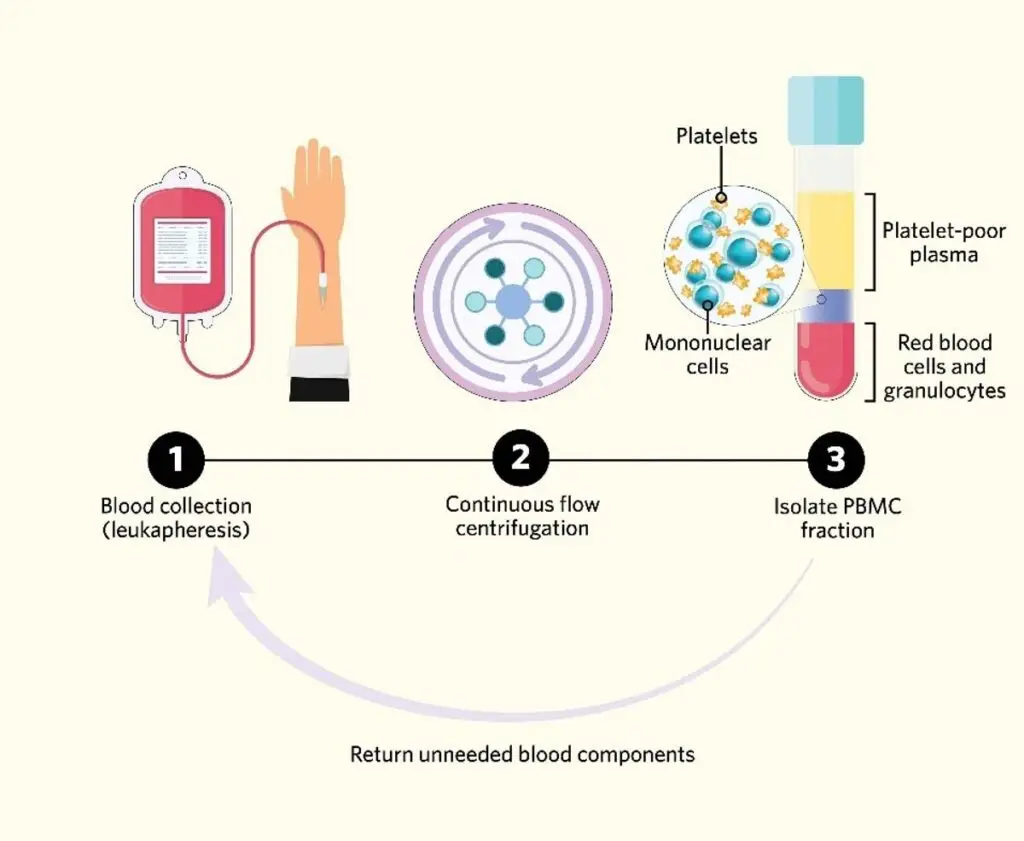Leukopheresis (Pediatrics)
What is Leukopheresis?
Leukopheresis, also known as leukapheresis, is a medical procedure that involves the selective removal of white blood cells (leukocytes) from a patient’s blood. Similar to other forms of apheresis, leukopheresis uses a specialized machine to separate blood components, allowing for the isolation and collection of white blood cells while returning the rest of the blood components to the patient’s circulation. Leukopheresis is typically performed to reduce the number of circulating leukocytes in patients with conditions such as leukemia, lymphoma, or other disorders characterized by abnormally high white blood cell counts. By selectively removing excess white blood cells, leukopheresis aims to alleviate symptoms, reduce disease burden, and improve overall patient outcomes.
What happens during Leukapheresis?
During leukopheresis, the patient is connected to a leukapheresis machine, which is a specialized device used to separate blood components. The procedure begins with the insertion of one or more intravenous lines, typically in the arm or another suitable vein, to allow blood to be drawn from the patient’s body.
The patient’s blood is then passed through the leukapheresis machine, where it undergoes centrifugation or filtration to separate the different blood components. The machine selectively removes white blood cells from the blood while returning the remaining blood components, including red blood cells, platelets, and plasma, back to the patient’s circulation.
The removed white blood cells are collected and processed, often for further examination or treatment, depending on the specific medical condition being treated.

How do you prepare for leukapheresis?
Preparation for leukapheresis entails several important steps. Initially, patients undergo a comprehensive medical evaluation, which includes a physical examination, review of medical history, and laboratory tests to assess overall health status and suitability for the procedure. Medications, including prescription drugs, over-the-counter medications, and supplements, are thoroughly reviewed with healthcare providers, as some may need to be adjusted or temporarily discontinued before leukapheresis. Adequate hydration is emphasized, with patients often instructed to drink plenty of fluids before the procedure to ensure sufficient blood flow during leukapheresis. Fasting may also be necessary in certain cases, particularly if sedation or anesthesia is required, to mitigate the risk of complications. Patients may need to make transportation arrangements to and from the medical facility, especially if sedation or anesthesia is involved. Overall, meticulous preparation for leukapheresis is crucial to ensure the safety and effectiveness of the procedure, and patients are advised to closely follow their healthcare provider’s instructions and address any concerns they may have.
What are the benefits of Leukapheresis?
Leukapheresis offers several benefits for patients with certain medical conditions, including:
- Reduction of Circulating White Blood Cells: Leukapheresis selectively removes excess white blood cells (leukocytes) from the bloodstream, which can be beneficial for patients with conditions characterized by abnormally high white blood cell counts, such as leukemia, lymphoma, or certain autoimmune disorders. By reducing the number of circulating white blood cells, leukapheresis helps alleviate symptoms and may improve overall disease management.
- Symptom Relief: For patients with conditions associated with elevated white blood cell counts, such as leukostasis syndrome or leukocytosis-induced symptoms like fatigue, fever, or respiratory distress, leukapheresis can provide rapid relief by lowering the white blood cell count and mitigating symptoms.
- Prevention of Complications: In conditions where elevated white blood cell counts contribute to complications such as organ dysfunction, tissue damage, or increased risk of thrombosis, leukapheresis helps prevent or reduce the severity of these complications by lowering the white blood cell count and improving blood flow.
- Adjunct to Other Treatments: Leukapheresis can serve as an adjunct to other treatments, such as chemotherapy or immunosuppressive therapy, by rapidly reducing the number of circulating white blood cells before or during the administration of these treatments. This can enhance the effectiveness of concurrent therapies and improve treatment outcomes.
- Stabilization for Stem Cell Collection: In patients undergoing hematopoietic stem cell transplantation, leukapheresis may be performed to collect sufficient numbers of hematopoietic stem cells from the bloodstream for transplantation. By selectively removing white blood cells, leukapheresis helps concentrate stem cells and facilitates their collection for transplantation, ultimately improving the success of the transplant procedure.
Leukopheresis is a targeted medical procedure designed to selectively remove white blood cells from a patient’s bloodstream using specialized apheresis technology. This procedure is particularly beneficial for patients with conditions such as leukemia, lymphoma, or autoimmune disorders characterized by elevated white blood cell counts. Leukapheresis aims to alleviate symptoms, reduce disease burden, and improve overall patient outcomes by selectively removing excess white blood cells while preserving other blood components. The benefits of leukapheresis include the reduction of circulating white blood cells, symptom relief, prevention of complications, adjunct to other treatments, and stabilization for stem cell collection in transplant patients. Overall, leukapheresis plays a crucial role in managing various medical conditions and enhancing the quality of life for affected patients.
